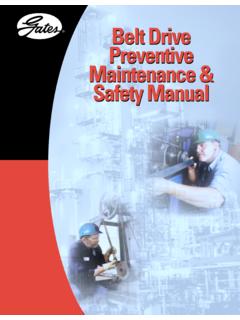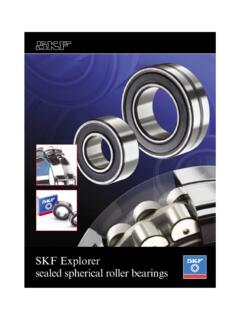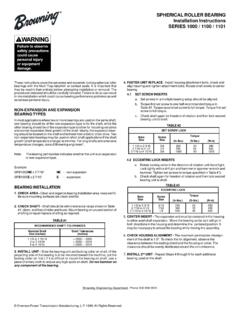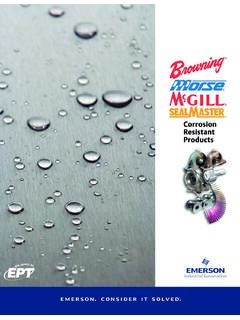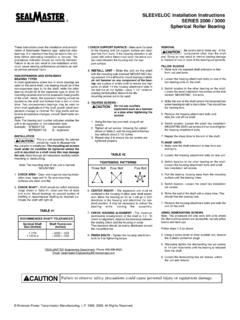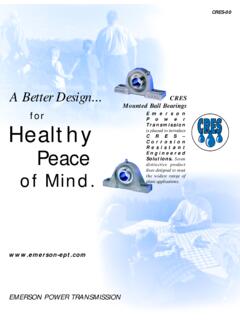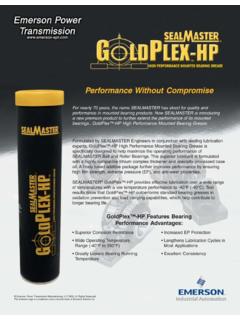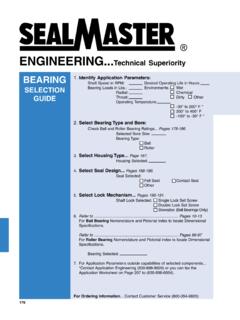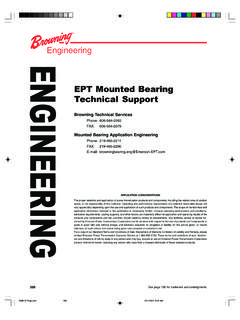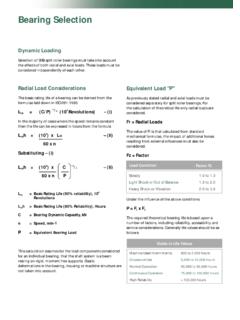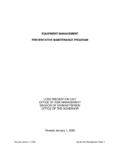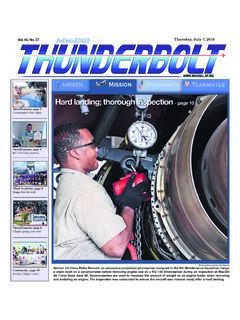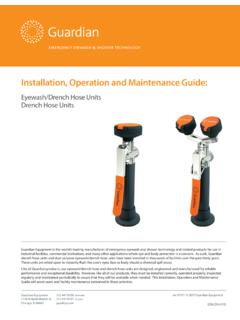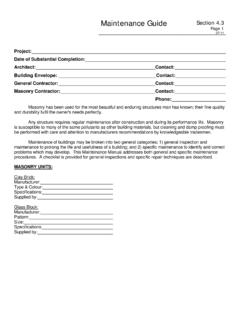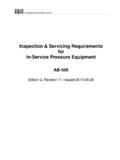Transcription of Belt Drive Preventive Maintenance & Safety Manual
1 Belt Drive . Preventive Maintenance &. Safety Manual TABLE OF CONTENTS. Drive SHUTDOWN & thorough inspection . Foreword Why Have a Preventive Maintenance Program? ..1. Maintaining a Safe Working Environment ..2. Drive Shutdown & thorough inspection Simple inspection ..3. Preventive Maintenance Checklist ..4. Preventive Maintenance Procedure ..5. How to Tension Belt Drives with a Gates Tension Tester ..6. Preventive Maintenance V-Belt Installation ..7-8. Pulley Installation ..9. Taper Lock Sheaves ..10. How to Install Synchronous Belts ..11. Belt Identification ..12-14. Belt Types ..15-17. Belt Styles ..18-20. Belt Drive Performance and Troubleshooting ..21-22. Troubleshooting Guide ..23-25. Problem/Solution Summary Table ..26-33. Troubleshooting Tools ..34-36. Technical Information ..37-45. Gates Belt & Sheave Design, Selection, Usage Publications ..46. Design Your Drives High Speed ..47. Low Speed ..48. Gates Regional Offices, Warehouses & Manufacturing ..Back Cover Sources of Drive Problems Copyright 2001.
2 The Gates Rubber Company Denver, Colorado 80217-5887 Printed in of America FOREWARD. Why Have A Preventive Maintenance Program? When compared to the constant lubrication problems associated with chain drives, or the mechanical prob- lems and high costs associated with gear drives, belts are the most cost-effective, reliable means of power transmission. However, optimum belt Drive performance requires proper Maintenance . The potential for long service life is built into every Gates belt. When coupled with a reg- ularly scheduled Maintenance program, your belts and belt drives will run relatively trouble-free for a long time. Belt Drive should have adequate guard * Note Section cut-outs for demo Carefully inspect all belts Power should be shut off and controls locked before inspecting Important to your business An effective Preventive Maintenance program saves your firm time and money. When you inspect and replace belts and faulty Drive components before they fail, you reduce costly downtime and production delays.
3 What is a good belt Maintenance program? A comprehensive, effective program of Preventive Maintenance consists of several elements: Maintaining a safe working environment Belt product knowledge Regularly scheduled belt Drive inspections Belt storage and handling Proper belt installation procedures Belt Drive performance evaluations Troubleshooting 1. FOREWARD. Maintaining A Safe Working Environment Maintain Safe Access to Drives It is common sense to establish a safe working environ- Always maintain a safe access to the belt drives. Keep ment in and around your belt drives. The following pre- area around drives free of clutter, debris and other cautions will make belt Drive inspection and mainte- obstructions. Floors should be clean and free of oil and nance easier and safer. debris to insure good footing and balance while work- ing on machinery. Checklist Always shut off power, lock and tag control box. Place all machine components in safe position. Remove guard, inspect and clean.
4 Inspect belt for wear, damage. Replace as needed. Inspect sheaves or sprockets for wear, alignment. Replace if worn. Inspect other Drive components such as bearings, shafts, motor mounts and takeup rails. Inspect static conductive grounding system (if used). Don't clutter area around belt Drive and replace components as needed. Check belt tension and adjust as needed. Drive Guards Recheck pulley alignment. Always keep drives properly guarded. Every belt Drive Reinstall belt guard. must be guarded when in operation. Guard must be Restart Drive . Look and listen for anything unusual. designed and installed according to OSHA standards. Wear Proper Clothing Never wear loose or bulky clothes, such as neckties, exposed shirttails, loose sleeves or lab coats around belt drives. Wear gloves while inspecting sheaves or sprockets to avoid being cut by nicks, burrs or sharply worn pulley edges. A properly guarded belt Drive A Properly Guarded Belt Drive A properly designed guard has the following features: Completely encloses Drive .
5 Grills or vents for good ventilation. Accessible inspection door or panels. No loose or bulky clothing Can easily be removed and replaced if damaged Where necessary, should protect the Drive from weather, debris and damage. Follow these precautions to make your Preventive main- tenance easier. 2. Drive SHUTDOWN & thorough inspection . Simple Drive inspection How Often To Inspect Begin Preventive Maintenance with a periodic Drive The following factors influence how often you need to inspection as a normal part of your Maintenance inspect a Drive . rounds. Look and listen for any unusual vibration or sound while observing the guarded Drive in operation. Critical nature of equipment A well designed and maintained Drive will operate Drive operating cycle smoothly and quietly. Accessibility of equipment Inspect guard for looseness or damage. Keep it free of Drive operating speed debris or dust and grime buildup on either the inside or Environmental factors the outside of the guard.
6 Any accumulation of material Temperature extremes in environment on the guard acts as insulation, and could cause drives to run hotter. Experience with your own equipment is your best guide to how often you need to inspect belt drives. Drives The effect of temperature on belt life is important. For operating at high speeds, heavy loads, frequent example, an internal temperature increase of 18 F (or stop/start conditions and at temperature extremes or approximately 36 F rise in ambient Drive temperature) operating on critical equipment require frequent may cut belt life in half. inspection . Also look for oil or grease dripping from guard. This may indicate over-lubricated bearings. If this material When To Perform Preventive Maintenance gets on rubber belts, they may swell and become dis- To help establish a Preventive Maintenance schedule, torted, leading to early belt failure. keep the following in mind. It's a good idea to check motor mounts for proper tight- Critical Drives ness.
7 Check take-up slots or rails to see that they are clean and lightly lubricated. A quick visual and hearing inspection may be needed every one to two weeks. Normal Drives With most drives, a quick visual and hearing inspection can be performed once a month. Complete inspection A Drive shutdown for a thorough inspection of belts, sheaves or sprockets and other Drive components may be required every three to six months. Remember, a well-designed industrial belt Drive is capable of operating for several years when properly maintained and used under normal conditions. Once the power is off, locked and tagged and the machine components are in safe positions, remove the guard and begin inspection . 3. Drive SHUTDOWN & thorough inspection . Drive SHUTDOWN & thorough inspection . Preventive Maintenance Check List By the following these steps, you can maintain a Drive efficiently, safely and with very little effort. 1. Always turn off the power to the Drive . Lock the control box and tag it with a warning sign Down For Maintenance .
8 Do Not Turn Power On.. Make sure you have power turned off for the correct Drive . Turn off power, lock controls and tag 2. Test to make sure correct circuit has been turned off. 3. Place all machine components in a safe (neutral). position. 7. Inspect other Drive components such as bearing, shafts, motor mounts and take-up rails. 4. Remove guard and inspect for damage. Check for signs of wear or rubbing against Drive compo- 8. Inspect static conductive grounding system (if nents. Clean and realign guard to prevent rubbing used) and replace components as needed. if necessary. 9. Check belt tension and adjust as needed. 5. Inspect belt for wear or damage. Replace as 10. Recheck sheave or sprocket alignment. needed. (See page 7 and 8 for belt replacement procedure.) See page 11 for synchronous belt pro- 11. Reinstall belt guard. cedure. 12. Turn power back on and restart Drive . Look and lis- 6. Inspect sheaves or sprockets for wear and mis- ten for anything unusual. alignment.
9 Replace if worn. (See page 9 and 10. These steps are covered in detail in the following for pulley installation procedure.). section. 4. Drive SHUTDOWN & thorough inspection . Preventive Maintenance Procedure or string. Sheave or sprockets can be checked for tilt- Once the power is off, locked and tagged, and the ing with a spirit level. machine components are in safe positions, remove the Three possible causes of sheave or sprocket misalign- guard and begin inspection . ment are: (See Fig. 1, page 9). How to Inspect a Belt 1. Motor shafts and driven machine shafts are not parallel Begin by inspecting the belt. Observing signs of unusual belt wear or damage can allow you to trou- 2. Pulleys not properly located on the shafts bleshoot possible Drive problems. 3 . Pulleys are tilted due to improper mounting Mark or note a point on the belt, or one of the belts in a multiple V-belt Drive . Work your way around the belt(s), Check Alignment Tolerances checking for cracks, frayed spots, cuts or unusual wear As a general rule, sheave misaligment on V-belt drives patterns.
10 Should be less than 1/2 or 1/10 per foot of Drive cen- Check the belt ter distance. Misalignment for synchronous, Polyflex . for excessive and Micro-V belts should be within 1/4 or 1/16 per heat. While belts foot of Drive center distance. do get hot during The greater the misalignment, the greater the chance of operations, if belt instability, increased belt wear, noise, vibration and they are too hot V-belt turnover. to touch, then troubleshooting Guard inspection is in order. The Check guard for wear or possible damage. Don't over- maximum tem- Begin by inspecting the belt look wear on the inside of guard. Clean the guard to perature at prevent it from becoming insulated and closed to venti- which a properly lation. Clean off any grease or oil that may have spilled maintained V-belt should operate is 140 F. onto the guard from over-lubricated bearings. Realign (185 F for Gates synchronous belts). guard. Belts should be replaced if there are obvious signs of cracking, fraying, unusual wear or loss of teeth in a tim- Check Other Drive Components ing, or synchronous, belt.
